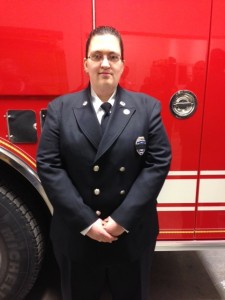By Leischen Stelter
The high-stress work involved in the Emergency Medical Services (EMS) profession creates a high turnover rate among professionals, but Dr. Shana Nicholson has managed to achieve 20 years of service—and counting.
Earlier in her career, Dr. Nicholson was involved in multiple high-trauma and high-stress situations inherent to EMS and fire service. For her, part of sustaining the energy for work meant taking time off when needed, even when she didn’t recognize the need was so great. Eventually, it also meant continuing her education so she could serve the profession in different ways.

Even with her impressive education credentials, her passion remains with EMS and fire service and she currently serves as a volunteer firefighter at Nutter Fort Fire Department in West Virginia. During the span of her ongoing 20-year career, she has seen a lot of changes in the industry. Education, for one, continues to play a big role in advancing the field.
Education has Helped Professionalize the Field, But Will it Reduce Turnover?
As education and technical requirements increase, EMTs, paramedics, and firefighters are better trained and more highly skilled than ever before. “Today education is much more important, and the field recognizes the value in it more than ever,” said Nicholson.
While this is great for the field (and for the average citizen in need of medical attention), an increase in educational requirements hasn’t helped lower turnover rates. As a matter of fact, it may actually increase turnover.
“Yes, we want to professionalize the field, but the money has to be there to back it up,” said Dr. Nicholson. “Why should someone go to college just to make the same amount of money as someone who works in a fast-food restaurant?” she asked.
Many skilled people who initially want to be EMTs, paramedics, or firefighters end up becoming nurses because it makes more financial sense.
“Local rescue squads don’t pay much. There’s really a lack of money available to back up the 
As a professor, Dr. Nicholson encourages those in EMS to consider pursuing a higher education. She often recommends degrees in public administration or emergency management—degrees that can apply to many different fields.
She recognizes how much her Emergency Services and Fire Science background has helped in her emergency management career. For example, having “boots on the ground” experience has provided her perspective during disaster situations. “Having been in the field for so long, I know that nothing is permanent, and I can see the broader picture,” she said. “Yes, we might be responding to a terrible disaster, but I can also see the next 10 phases towards recovery, and I don’t get bogged down about the initial impact.”
Advancing the field of public safety and improving turnover rates goes beyond education, and Dr. Nicholson emphasized that there must be a focus on taking care of the health of EMTs, paramedics and firefighters.
Raising the Bar for Physical and Mental Wellness
While awareness about mental health and wellness has been a much more prominent topic in the EMS community for the last 10 to15 years, there is still not enough being done to address the trauma experienced by these public safety professionals.
“We see terrible things—we, as humans, aren’t designed to be under constant stress like this,” said Dr. Nicholson. “In terms of actually taking care of our mental, emotional and spiritual-wellbeing, that is certainly lacking in the profession and there’s only a minimal effort being put towards addressing it.”
Part of the problem is continued resistance by personnel themselves to acknowledge trauma and emotional distress. Despite an increase in agencies offering formal resources to address PTSD and trauma, admitting that you have a problem “still implies a weakness,” said Nicholson. “The standard coping mechanism for EMS and fire services is to put your boots on and go back out. That will never change.”
Addressing overall wellness is more than just a focus on mental health, and there needs to be a renewed focus on physical health. There are high obesity rates among EMTs, paramedics and firefighters, often due to crazy schedules that make healthy eating and regular exercise extremely difficult. Also, in order to deal with stress, many people turn to unhealthy and destructive behavior such as alcohol abuse. It is important for departments to make sure that personnel are remaining physically healthy and receiving regular physical evaluations.
“It wouldn’t be a popular idea and it certainly will come with a financial cost, but it is an important step in the right direction for career longevity,” said Dr. Nicholson.
Comments are closed.